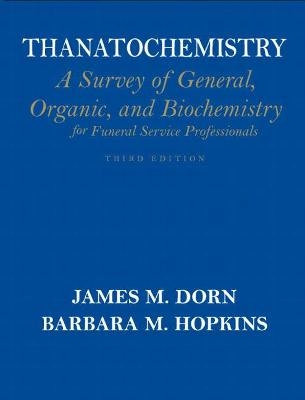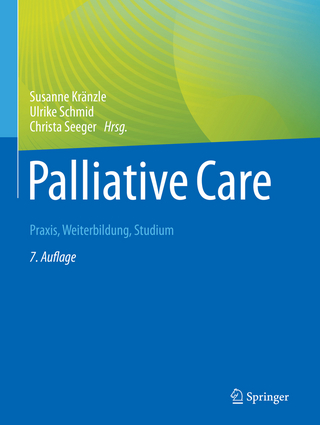
Thanatochemistry
Pearson (Verlag)
978-0-13-602687-7 (ISBN)
James M. Dorn received his B.S. in Biology and a Chemistry Minor from Loyola University in Chicago, Illinois. He then went on to receive his M.S. in Virology at the University Of Cincinnati College Of Engineering. He is very involved in the field of embalming. He is an Ohio Licensee in Embalming and Funeral Directing, a member of Ohio Funeral Directors Association Disaster Response Team, a member of Ohio Embalmers Association, a Chairman American Board of Funeral Service Education National Board Examination Liaison Committee, the Vice President University Mortuary Science Education Association, and also an Education Consultant at the Academy of Professional Funeral Service Practice. Currently, James M. Dorn is the Chairman of the Department of Embalming Sciences at the Cincinnati College of Mortuary Science and is currently teaching Anatomy, Chemistry, Pathology and Microbiology. Dr. Barbara Hopkins received her B.A. and Ph.D. from the Catholic University of America. She is currently the Associate Professor and Chair of the chemistry department at Xavier University in Cincinnati, Ohio. Her areas of expertise are Laser Induced Fluorescence, ICP-AES of organo-metal compounds. She received the McDonald Award for Outstanding Teaching in the Sciences in 1999.
PART I General Chemistry
Chapter 1 Introduction
Definition of Chemistry
Divisions of Chemistry
Chemical Measurements
Chapter Summary
Questions
Chapter 2 Physical and Chemical Changes
Physical Properties
Chemical Properties
Physical and Chemical Changes
Chapter Summary
Questions
Chapter 3 States and Types of Matter
Solid→Liquid→Gas
Solid→Gas
Characteristics of States of Matter
Types of Matter
Chapter Summary
Questions
Chapter 4 Atomic Structure and Chemical Bonding
Atoms
The Periodic Table
Chemical Bonding
Chapter Summary
Questions
Chapter 5 Chemical Shorthand: Symbols, Formulas, and Equations
Symbols
Formulas
Molecular Mass
Naming of Compounds
Equations
Chapter Summary
Questions
Chapter 6 Radiation Chemistry
Radioactivity
Transmutation
Half-Life
Artificial Transmutations
Radiation Quantities and Units
Radiation Detectors
Protection from Radiation
Sources of Radiation Encountered by Embalmers
Vehicles of Radionuclide Therapy
Preparation of the Body Without Autopsy
Preparation of the Autopsied Body
Cremation
Summary of Precautionary Procedures
Chapter Summary
Questions
Chapter 7 Oxygen
Facts about Oxygen
Physical Properties
Chemical Properties
Methods for the Preparation of Oxygen
Factors Affecting Reaction Rates
Forms of Oxygen
Chapter Summary
Questions
Chapter 8 Hydrogen
Facts about Hydrogen
Physical Properties
Chemical Properties
Preparation of Hydrogen
Chapter Summary
Questions
Chapter 9 Water
Facts about Water
Physical Properties
Hydrogen Bonding
Chemical Properties
Preparation of Water
Classes of Impurities in Water
Hardness in Water
Other Purification Methods
Chapter Summary
Questions
Chapter 10 Solutions
Types and Components of Solutions
Solubility
Concentration Terms
Properties of Solutions
Application of Osmotic Principles to Embalming
Colloids and Suspensions
Chapter Summary
Questions
Chapter 11 Acids, Bases, Salts, and Ionization
Self-Ionization of Water
Definitions of Acids and Bases
Arrhenius Theory
Common Aqueous Bases
Properties of Aqueous Acids and Bases
Brønsted–Lowry Theory
Lewis Theory
Anhydrides
Salts
Ionization
pH: Hydrogen-Ion Concentration
Chapter Summary
Questions
Chapter 12 Hydrates and Hydrolysis
Hydrates
Hydrolysis
Chapter Summary
Questions
PART II Organic Chemistry
Chapter 13 Introduction
Nature of Organic Chemistry
Properties of Carbon
Functional Groups
Formulas
Chapter Summary
Questions
Chapter 14 Hydrocarbons
Types and Properties of Hydrocarbons
Aromatic Hydrocarbons
Polynuclear Aromatic Hydrocarbons
Sources of Aromatic Compounds
Chapter Summary
Questions
Chapter 15 Alcohols and Ethers
Alcohols
Important Alcohols in Embalming
Phenols
Cresols
Resorcinol
Hexyl Resorcinol
Hexachlorophene
Comparison of Alcohols as Germicides
Thioalcohols (Mercaptans)
Ethers
Chapter Summary
Questions
Chapter 16 Aldehydes and Ketones
Aldehydes
Ketones
Chapter Summary
Questions
Chapter 17 Carboxylic Acids and Esters
Structure of Organic Acids
Monocarboxylic Acids
Aromatic Carboxylic Acids
Acidic Nature of Carboxylic Acids
Organic Salts
Dicarboxylic Acids
Hydroxy Acids
Chelates
Lactic Acid
Esters
Thioesters
Chapter Summary
Questions
Chapter 18 Amines and Amides
Amines
Reactions of Amines
Aromatic Amines
Heterocyclic Amines
Quaternary Ammonium Compounds
Chapter Summary
Questions
PART III BIOCHEMISTRY
Chapter 19 Introduction
Elemental Composition
Molecular Composition
Macromolecules
Metabolism
Chapter Summary
Questions
Chapter 20 Proteins
Protein Composition
Amino Acids
Amphoterism
Peptide Linkage
Cross-Linking of Proteins
Protein Structure
Hemoglobin
Breakdown of Hemoglobin
Denaturation
Protein Breakdown
Chapter Summary
Questions
Chapter 21 Enzymes
Enzyme Function
Nomenclature
Chemical Properties of Enzymes
Regulation of Enzyme Activity
The Role of Enzymes in Decomposition
Chapter Summary
Questions
Chapter 22 Carbohydrates
Definition and Classification
Monosaccharides
Disaccharides
Polysaccharides
Proteoglycans
Reactions of Carbohydrates
Synthesis of Adenosine Triphosphate
Muscle Contraction: Rigor Mortis
Chapter Summary
Questions
Chapter 23 Lipids
Classification of Lipids
Simple Lipids
Compound Lipids
Miscellaneous Lipids
Reactions of Lipids
Significance of Lipids to the Embalming Process
Chapter Summary
Questions
Chapter 24 Summary of the Action and Composition of Embalming Fluids
Actions of Preservative Chemicals
Preservation by Formaldehyde
Embalming Fluids: Basic Types
Factors Influencing Stability of Fluids (Shelf Life)
Potentially Hazardous Chemicals used in Embalming or Present in the Mortuary
Chapter Summary
Questions
Appendix A
Appendix B
Glossary
Index
| Sprache | englisch |
|---|---|
| Maße | 185 x 240 mm |
| Gewicht | 660 g |
| Themenwelt | Medizin / Pharmazie ► Pflege ► Palliativpflege / Sterbebegleitung |
| Naturwissenschaften ► Chemie | |
| ISBN-10 | 0-13-602687-7 / 0136026877 |
| ISBN-13 | 978-0-13-602687-7 / 9780136026877 |
| Zustand | Neuware |
| Haben Sie eine Frage zum Produkt? |
aus dem Bereich


